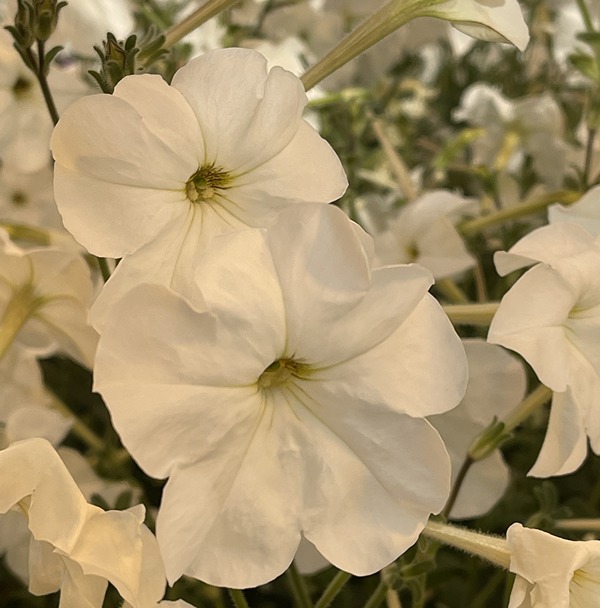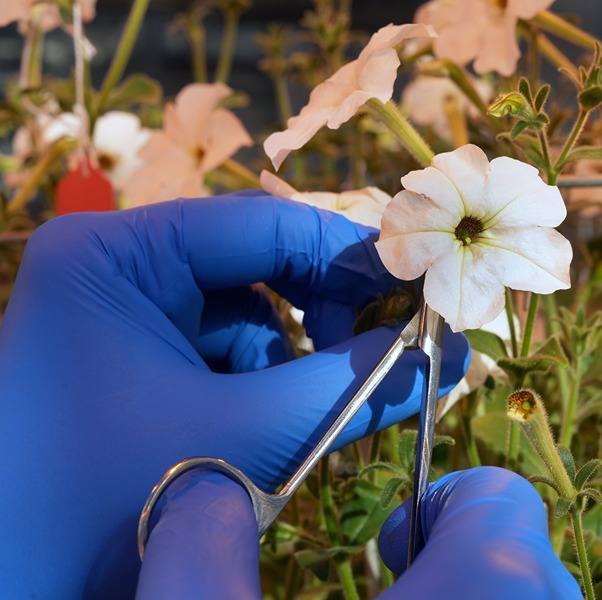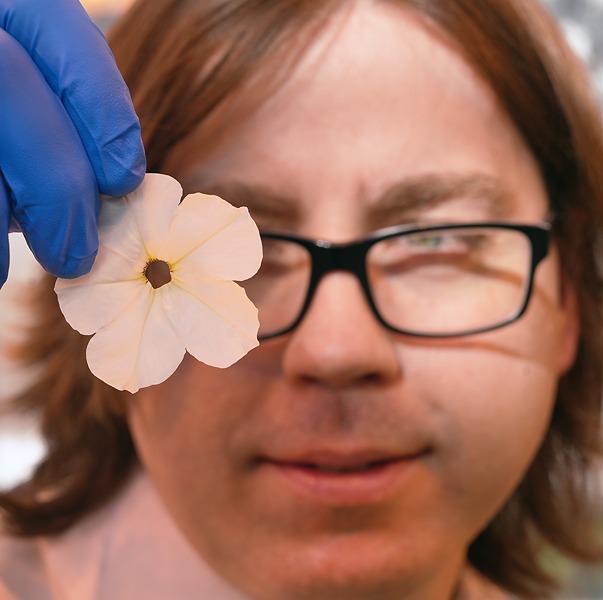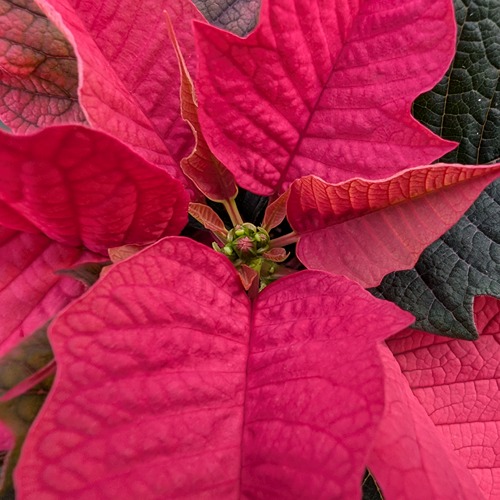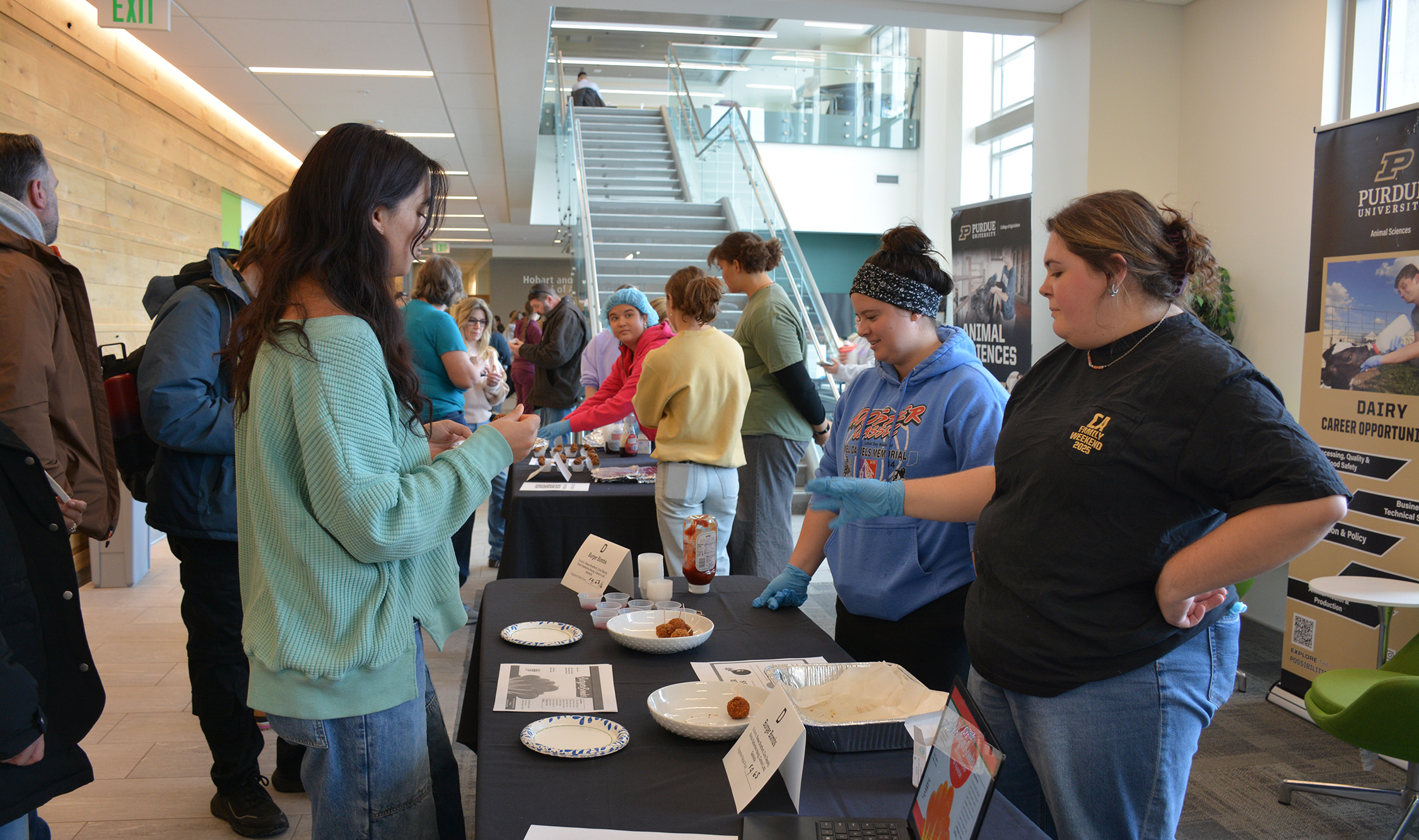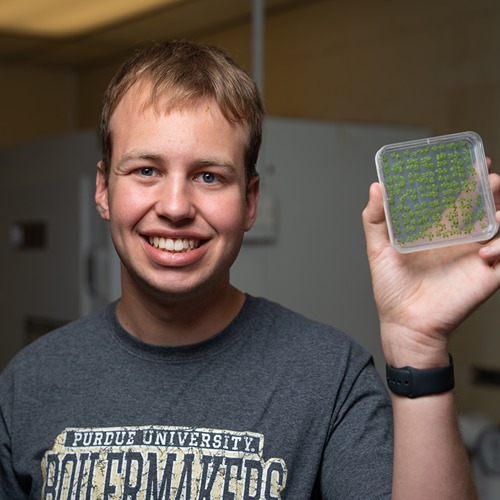Stop and smell the volatile secondary metabolites
how the day-night cycle alters petunia genome activity and scent production
As Ying Li steps through the door, Natalia Dudareva stops mid-sentence to spin around and meet her with a sly grin and the words, “I’ve got exciting news for you.”
The two are quick to fall into step with each other. Over papers piled high in Dudareva’s office, the collaborators share pictures of white blossoms that would make stellar journal covers and scribble rough diagrams to try and explain their latest research question to each other.
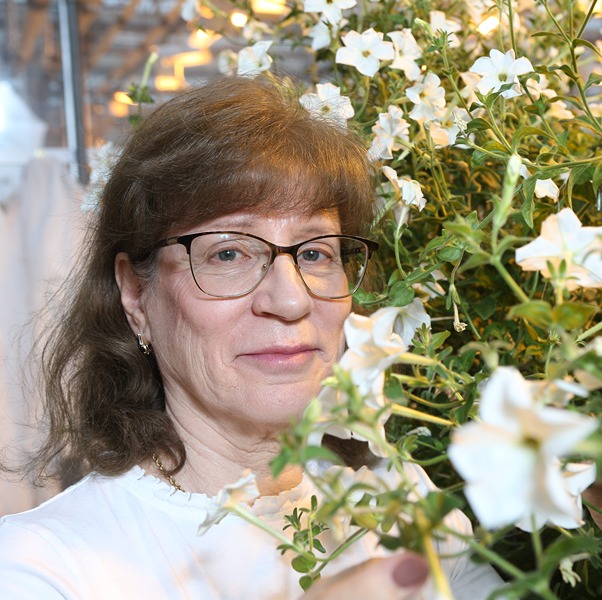 Dudareva, a distinguished professor in the Department of Biochemistry and the director of the Center for Plant Biology at Purdue, has been studying petunias for nearly three decades. She studies compounds called secondary metabolites, which are not essential for growth but are important resources. The plants use them to signal defense responses when a pest is around or to attract pollinators, and humans harvest them for use in everything from perfumes to medicines.
Dudareva, a distinguished professor in the Department of Biochemistry and the director of the Center for Plant Biology at Purdue, has been studying petunias for nearly three decades. She studies compounds called secondary metabolites, which are not essential for growth but are important resources. The plants use them to signal defense responses when a pest is around or to attract pollinators, and humans harvest them for use in everything from perfumes to medicines.
Some of the secondary metabolites seem to run on an internal clock. As Dudareva pointed out, “Snapdragons are pollinated by bees during the day, so their highest level of scent emission happens during the day. The petunia we study smells the best towards evening because the pollinator is active in the evening.”
Pollination is one of the classic forms of mutualistic symbiosis, where one organism helps the other and gets help in return. Petunias offer sweet nectar for moths and release a strong scent made of volatile secondary metabolites to guide their co-evolved friend to their flowers, and moths move their pollen from one flower to another in return for the late-night snack.
Since moths are nocturnal, petunias can save their resources and energy during the day and only have to release the scent at night. Dudareva knew these secondary metabolites were somehow being regulated by gene expression, but it was research outside of her typical scope.
Li, an associate professor in Horticulture & Landscape Architecture, studies the regulation of genes and how the histone proteins that DNA winds around can be modified to control how much a gene is expressed. This field of study, called epigenetics, could be used to carve out the story of how petunias only release a scent at night.
how the histone proteins that DNA winds around can be modified to control how much a gene is expressed. This field of study, called epigenetics, could be used to carve out the story of how petunias only release a scent at night.
“How does a flower achieve this? That's what got me interested,” Ying shared. “You need 70 to 100 genes to work together to make this scent, and they are on at the same time. So we started looking at whether there is an epigenetic-level regulation, like whether the histone modification of those genes are changed in a day-night cycle so that these things can be turned on at the right time of the day.”
Histone proteins can be modified in several ways. For instance, an acetyl tag can be added to histones in acetylation, which loosens the DNA and makes it more available to be transcribed and active.
Li and Dudareva’s labs tracked the histone modifications in petunias for 24-hour cycles and saw that there were oscillations in the histones’ changes that tracked the day and night much like a circadian rhythm. The histones were acetylated in the evening, meaning that they turned on genes involved with petunia’s scent, but those acetyl marks were rapidly removed in the morning, turning those same genes off.
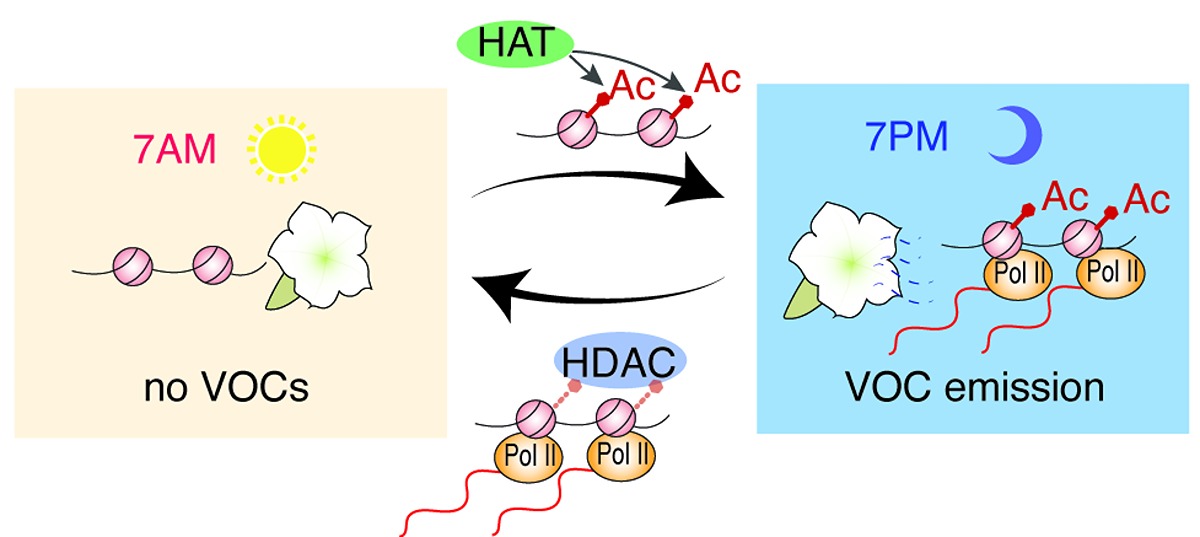 In the morning, the genes behind volatile secondary metabolite (VOC) production are turned off. When the histones associated with those genes are given acetyl tags (Ac), they are turned on and a scent is produced at night to attract moths for pollination. Overnight, the acetyl tags are removed, and the genes are turned back off to save resources and energy.
In the morning, the genes behind volatile secondary metabolite (VOC) production are turned off. When the histones associated with those genes are given acetyl tags (Ac), they are turned on and a scent is produced at night to attract moths for pollination. Overnight, the acetyl tags are removed, and the genes are turned back off to save resources and energy. They also found that there were some genes that showed bigger oscillations in their histone modifications than others. These strong oscillators experienced a greater flux of acetylation-mark removal overnight than did their modest counterparts.
Li explained, “They work together to produce the scent. The ones that have strong oscillations are master regulators that control everything, transporters that allow the scent to go out of the cell or enzymes involved in making the precursor of different scent molecules. Modest oscillators have more downstream roles in producing the scent.”
Their research, funded at first by a seed grant from the Center of Plant Biology and later by a $1,002,041 NSF grant, was recently published in New Phytologist. There’s still a lot to be explored and discovered with the genes involved, the histone modifications and the protein pairs that add and remove acetylation marks. Dudareva and Li are opening doors to observe the multitude of dynamic switches involved in plants’ complex lives.
They have also spent the last couple of years opening doors for each other. Like the moth and the petunia, they’ve formed a kind of symbiosis. Their research scopes were complementary; Dudareva had the knowledge of secondary metabolites and petunia research, and Li brought the epigenetics side to the table. Only by working together were they able to tell this story.
Their symbiosis went beyond the lab. During the pandemic, Li and Dudareva bonded on zoom calls over their shared professional and personal struggles and joys, including those of motherhood.
“The message I want to send to researchers is that it’s possible to balance family and career. It's possible to do both with good collaborators,” Li says with a nod of gratitude towards her own collaborator before walking out of Dudareva’s office.
As she rushes to join another meeting on her desktop, Dudareva responds, “In life, everything is possible, and never giving up is the most important thing.”
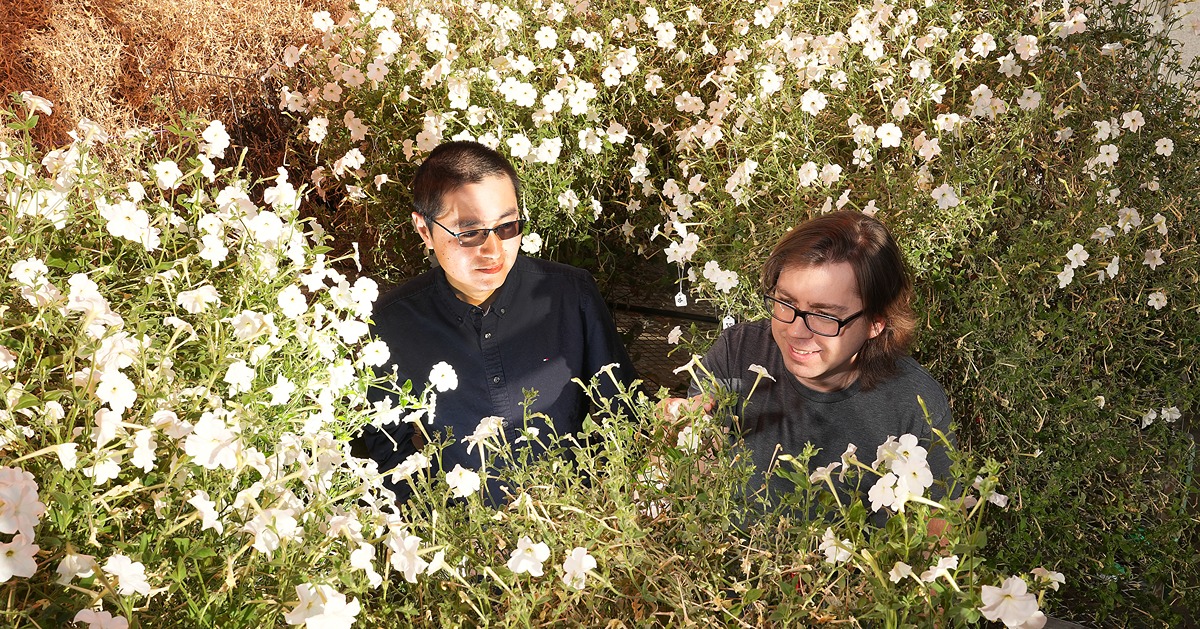 Much like their principal investigators, postdoctoral researchers Xingqi Huang (left) from Dudareva's lab and Ryan Patrick (right) from Li's lab worked together on this project and developed a friendship over the years. After helping unscramble the mystery of how petunias only release a scent at night, they are first two authors on the new paper from their combined labs.
Much like their principal investigators, postdoctoral researchers Xingqi Huang (left) from Dudareva's lab and Ryan Patrick (right) from Li's lab worked together on this project and developed a friendship over the years. After helping unscramble the mystery of how petunias only release a scent at night, they are first two authors on the new paper from their combined labs. 